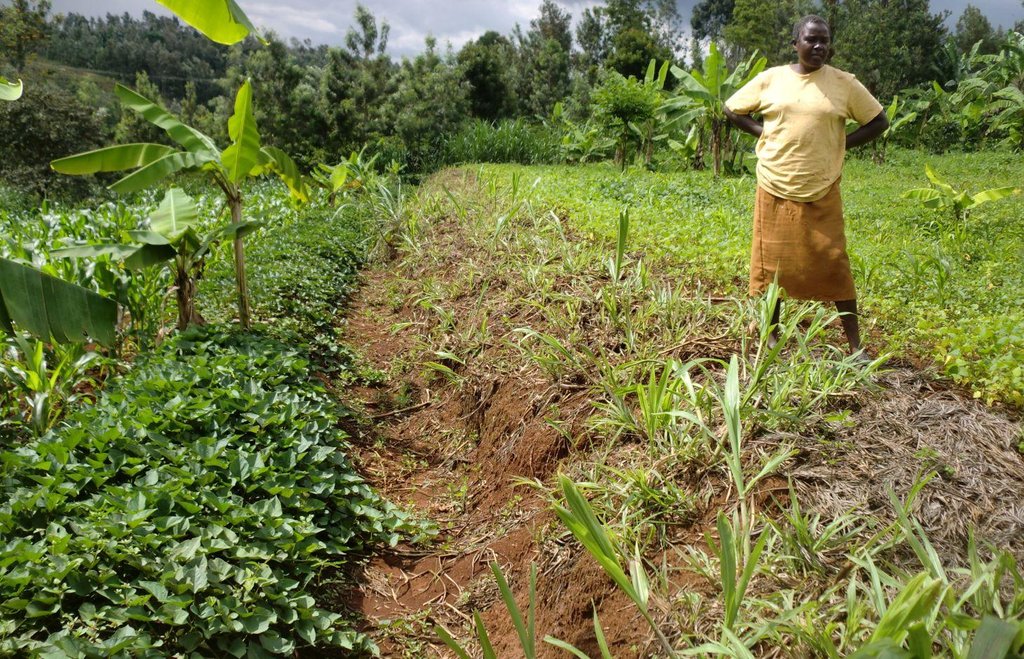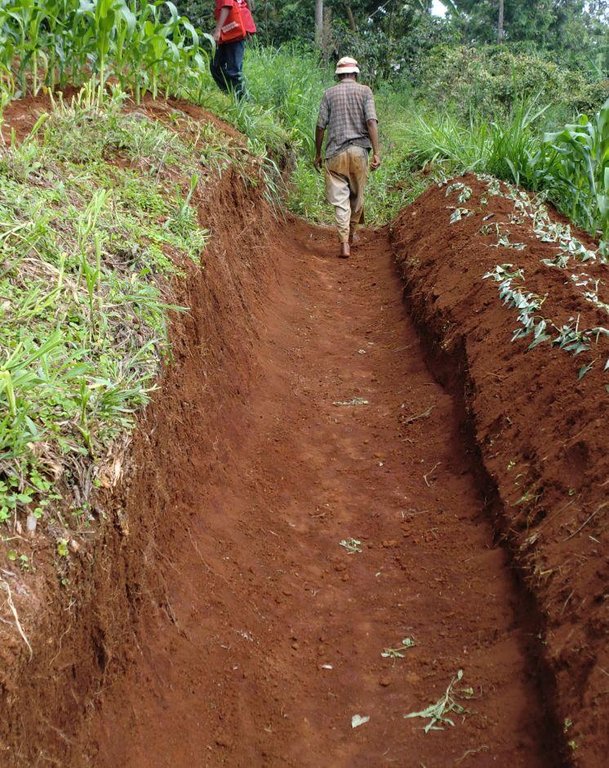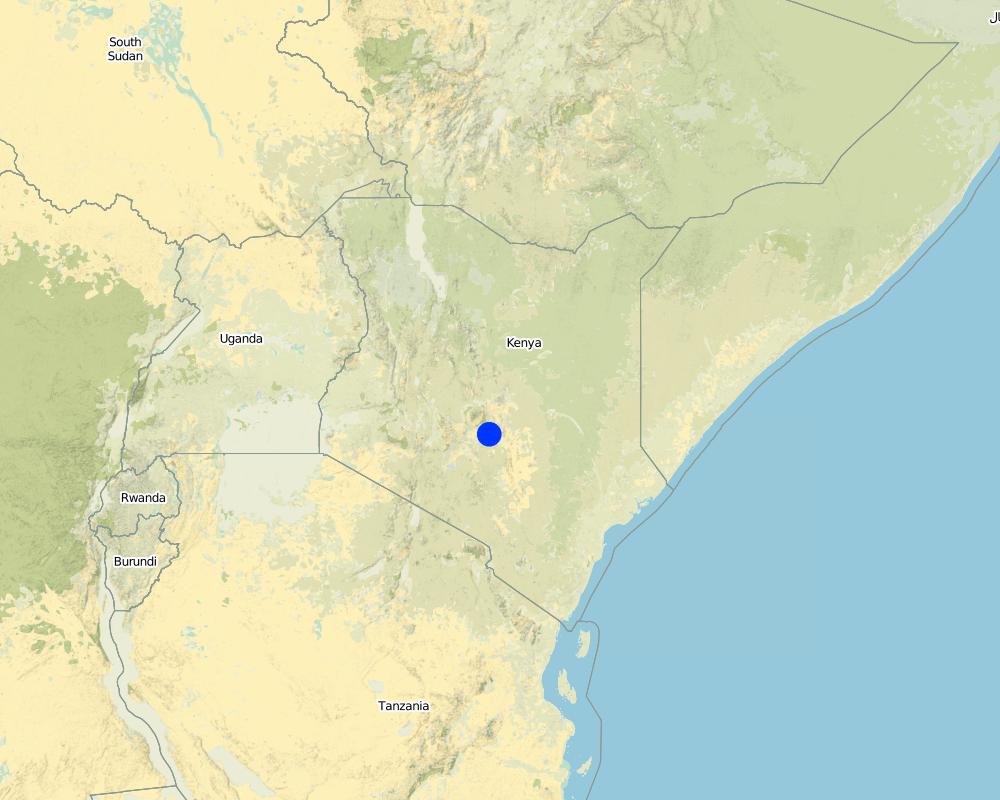Fanya Juu Terraces - Nappier grass+Swetpotatoes [肯尼亚]
- 创建:
- 更新:
- 编制者: Paul Kahiga
- 编辑者: –
- 审查者: Fabian Ottiger
Fanya Juu Terraces - Nappier grass+Swetpotatoes
technologies_1243 - 肯尼亚
查看章节
全部展开 全部收起1. 一般信息
1.2 参与该技术评估和文件编制的资源人员和机构的联系方式
SLM专业人员:
Gathenya Mwangi
Jomo Kenyatta University of Agriculture and Technology
P.O.Box, 62000-00200, Nairobi, Juja, Kenya
肯尼亚
SLM专业人员:
Home Patrick
Jomo Kenyatta University of Agriculture and Technology
P.O.Box, 62000-00200, Nairobi, Juja, Kenya
肯尼亚
SLM专业人员:
Chege Timothy
Jomo Kenyatta University of Agriculture and Technology
P.O.Box, 62000-00200, Nairobi, Juja, Kenya
肯尼亚
SLM专业人员:
Omwange Abamba
Jomo Kenyatta University of Agriculture and Technology
P.O.Box, 62000-00200, Nairobi, Juja, Kenya
肯尼亚
SLM专业人员:
Kimengich Baobab
Jomo Kenyatta University of Agriculture and Technology
P.O.Box, 62000-00200, Nairobi, Juja, Kenya
肯尼亚
SLM专业人员:
Wamuongo Jane
+254 729 054547
Kenya Agricultural Research Institute
Nairobi
肯尼亚
SLM专业人员:
Karanja Andrew
+254 729 054547
Kenya Agricultural Research Institute
Nairobi
肯尼亚
SLM专业人员:
Namirembe Sara
+254-20-722-4000
World Agroforestry Centre
United Nations Avenue, Gigiri PO Box 30677-00100 Nairobi
肯尼亚
有助于对技术进行记录/评估的机构名称(如相关)
International Centre for Research in Agroforestry (ICRAF) - 肯尼亚有助于对技术进行记录/评估的机构名称(如相关)
Jomo Kenyatta University (Jomo Kenyatta University) - 肯尼亚有助于对技术进行记录/评估的机构名称(如相关)
KARI Headquarters (KARI Headquarters) - 肯尼亚1.3 关于使用通过WOCAT记录的数据的条件
(现场)数据是什么时候汇编的?:
18/09/2012
编制者和关键资源人员接受有关使用通过WOCAT记录数据的条件。:
是
1.4 所述技术的可持续性声明
这里所描述的技术在土地退化方面是否存在问题,导致无法被认为是一种可持续的土地管理技术?:
否
2. SLM技术的说明
2.1 技术简介
技术定义:
Fanya juu terraces stabilized with nappier grass and sweet potatoes are earth bunds created by digging a trench along a contour and throwing the soil up slope to form an embankment that is stabilized with nappier grass and during maintenance phase, the accumulated sediments are removed and thrown on the lower side and stabilized with sweet potatoes.
2.2 技术的详细说明
说明:
The cross-sectional profile of a fanya juu terrace comprises an embankment to impound water, soil and nutrients, a storage area above the embankment to prevent overtopping by runoff and a berm or ledge to prevent the embankment soil from sliding bank into the trench. The trench below the embankment may or be retained. A Fanya juu terrace is often the first stage in the development of a bench terrace.
Purpose of the Technology: They effectively reduces slope-length, and hence soil erosion from steep croplands. In some cases, enlarged embankments are made to allow ponding of harvested runoff and, therefore, the structure can be used in water harvesting systems having external catchments. The soil bund retains water and thereby, safeguards yields even during droughts. In Embu County, farmers are very innovative. They ussually stabilize the up slope soil with nappier grass (fodder) and during the maintenance phase, the silt/sediments in the trench is scoped and thrown on the lower side where is stabilized with sweet potatoes vines.
Establishment / maintenance activities and inputs: The construction of fanya juu terraces is labor intensive and involves digging a trench on the contour and throwing the soil up slope to form an embankment. Construction is carried out after laying out pegs on the contour, or at a gradient, as required. A berm of 15cm to 30 cm is left to prevent the embankment soil up slope to form an embankment, which should be stabilized with grass. The excavated trench should be as narrow as possible to reduce wastage of cultivated land. Where the trench can be used for planting tree crops such as bananas, it should be wide enough to accommodate the crop. The embankment should be planted with perennial grass to stabilize it.
Natural / human environment: Fanya juu terraces are popular in smallholder farms particularly in semi arid areas where they are quite effective in conserving moisture and nutrients. They are applicable in areas where soils are too shallow for level bench terracing and on moderately steep slopes (e.g. below 20%) They are not suitable for stony soil. They normally develop into out ward sloping bench terraces after a few years depending on the amount of soil which moves down slope and lodges above the embankment.
2.3 技术照片
2.5 已应用该技术的、本评估所涵盖的国家/地区/地点
国家:
肯尼亚
区域/州/省:
Eastern Province
有关地点的进一步说明:
Mbere South District
Map
×2.7 技术介绍
详细说明该技术是如何引入的:
- 通过土地使用者的创新
3. SLM技术的分类
3.1 该技术的主要目的
- 改良生产
- 减少、预防、恢复土地退化
- 创造有益的经济影响
3.2 应用该技术的当前土地利用类型

农田
- 一年一作
注释:
Major land use problems (compiler’s opinion): The technology is safe for soil erosion conservation
Major land use problems (land users’ perception): There has been a lot of erosion due to poor protective measures. But the technology has successively manged to curb the continued erosion
Future (final) land use (after implementation of SLM Technology): Cropland: Ca: Annual cropping
如果由于技术的实施而导致土地用途发生变化,则在技术实施前说明土地利的用途。:
Cropland: Ca: Annual cropping
3.3 有关土地利用的更多信息
该技术所应用土地的供水:
- 混合雨水灌溉
每年的生长季节数:
- 1
3.4 该技术所属的SLM组
- 横坡措施
3.5 技术传播
具体说明该技术的分布:
- 均匀地分布在一个区域
如果该技术均匀地分布在一个区域上,请注明覆盖的大致区域。:
- < 0.1 平方千米(10 公顷)
3.6 包含该技术的可持续土地管理措施

结构措施
- S2:堤、岸
3.7 该技术强调的主要土地退化类型

土壤水蚀
- Wt:表土流失/地表侵蚀
注释:
Main causes of degradation: soil management, Heavy / extreme rainfall (intensity/amounts), poverty / wealth
Secondary causes of degradation: labour availability
3.8 防止、减少或恢复土地退化
具体数量名该技术与土地退化有关的目标:
- 防止土地退化
- 修复/恢复严重退化的土地
4. 技术规范、实施活动、投入和成本
4.1 该技术的技术图纸
4.2 技术规范/技术图纸说明
The technical drawing on the left hand side shows a typical fanya juu terrace stabilized with nappier grass on the upper slope and sweet potatoes vines on the lower down slope.
Location: Ena Location. Eastern Province
Date: 12.11.2012
Technical knowledge required for field staff / advisors: moderate (The extension officers need to demonstrate on how to construct the terraces)
Technical knowledge required for land users: high (The technology is good because it completely reduces soil losses)
Main technical functions: control of concentrated runoff: retain / trap
4.3 有关投入和成本计算的一般信息
其它/国家货币(具体说明):
Kshs
注明美元与当地货币的汇率(如相关):1美元=:
100.0
注明雇用劳工的每日平均工资成本:
5.00
4.4 技术建立活动
| 活动 | 措施类型 | 时间 | |
|---|---|---|---|
| 1. | Setting out the contours | 结构性的 | Initial stages |
| 2. | Digging out the trench | 结构性的 | After setting the contour |
| 3. | Planting nappier grass | 结构性的 | on the up slope |
| 4. | Removing the sediments | 结构性的 | maintenance phase |
| 5. | Planting of sweet potatoes | 结构性的 | maintenance phase |
4.5 技术建立所需要的费用和投入
| 对投入进行具体说明 | 单位 | 数量 | 单位成本 | 每项投入的总成本 | 土地使用者承担的成本% | |
|---|---|---|---|---|---|---|
| 劳动力 | Labour | ha | 1.0 | 200.0 | 200.0 | 100.0 |
| 设备 | Tools | ha | 1.0 | 25.0 | 25.0 | 100.0 |
| 其它 | Cuttings | ha | 1.0 | 30.0 | 30.0 | 100.0 |
| 技术建立所需总成本 | 255.0 | |||||
4.7 维护/经常性活动所需要的费用和投入(每年)
| 对投入进行具体说明 | 单位 | 数量 | 单位成本 | 每项投入的总成本 | 土地使用者承担的成本% | |
|---|---|---|---|---|---|---|
| 劳动力 | Labour | ha | 1.0 | 150.0 | 150.0 | 100.0 |
| 设备 | Tools | ha | 1.0 | 150.0 | 150.0 | 100.0 |
| 其它 | Cuttings | ha | 1.0 | 150.0 | 150.0 | 100.0 |
| 技术维护所需总成本 | 450.0 | |||||
注释:
length of the structure
4.8 影响成本的最重要因素
描述影响成本的最决定性因素:
labour
5. 自然和人文环境
5.1 气候
年降雨量
- < 250毫米
- 251-500毫米
- 501-750毫米
- 751-1,000毫米
- 1,001-1,500毫米
- 1,501-2,000毫米
- 2,001-3,000毫米
- 3,001-4,000毫米
- > 4,000毫米
农业气候带
- 半湿润
Thermal climate class: subtropics
5.2 地形
平均坡度:
- 水平(0-2%)
- 缓降(3-5%)
- 平缓(6-10%)
- 滚坡(11-15%)
- 崎岖(16-30%)
- 陡峭(31-60%)
- 非常陡峭(>60%)
地形:
- 高原/平原
- 山脊
- 山坡
- 山地斜坡
- 麓坡
- 谷底
垂直分布带:
- 0-100 m a.s.l.
- 101-500 m a.s.l.
- 501-1,000 m a.s.l.
- 1,001-1,500 m a.s.l.
- 1,501-2,000 m a.s.l.
- 2,001-2,500 m a.s.l.
- 2,501-3,000 m a.s.l.
- 3,001-4,000 m a.s.l.
- > 4,000 m a.s.l.
5.3 土壤
平均土层深度:
- 非常浅(0-20厘米)
- 浅(21-50厘米)
- 中等深度(51-80厘米)
- 深(81-120厘米)
- 非常深(> 120厘米)
土壤质地(表土):
- 中粒(壤土、粉土)
表土有机质:
- 中(1-3%)
如有可能,附上完整的土壤描述或具体说明可用的信息,例如土壤类型、土壤酸碱度、阳离子交换能力、氮、盐度等。:
Soil fertility: Medium
Soil drainage/infiltration: Good
Soil water storage capacity: Medium
5.4 水资源可用性和质量
地下水位表:
5-50米
地表水的可用性:
好
水质(未处理):
良好饮用水
5.5 生物多样性
物种多样性:
- 中等
5.6 应用该技术的土地使用者的特征
生产系统的市场定位:
- 混合(生计/商业
非农收入:
- 低于全部收入的10%
相对财富水平:
- 平均水平
个人或集体:
- 个人/家庭
机械化水平:
- 手工作业
性别:
- 女人
- 男人
说明土地使用者的其他有关特征:
Land users applying the Technology are mainly common / average land users
Population density: < 10 persons/km2
Annual population growth: 0.5% - 1%
5.7 应用该技术的土地使用者拥有或租用的平均土地面积
- < 0.5 公顷
- 0.5-1 公顷
- 1-2 公顷
- 2-5公顷
- 5-15公顷
- 15-50公顷
- 50-100公顷
- 100-500公顷
- 500-1,000公顷
- 1,000-10,000公顷
- > 10,000公顷
这被认为是小规模、中规模还是大规模的(参照当地实际情况)?:
- 小规模的
5.8 土地所有权、土地使用权和水使用权
土地所有权:
- 个人,有命名
土地使用权:
- 个人
用水权:
- 个人
5.9 进入服务和基础设施的通道
健康:
- 贫瘠
- 适度的
- 好
教育:
- 贫瘠
- 适度的
- 好
6. 影响和结论性说明
6.1 该技术的现场影响
社会经济效应
生产
作物生产
饲料生产
土地管理
收入和成本
农业收入
工作量
社会文化影响
健康状况
SLM/土地退化知识
生态影响
水循环/径流
水的回收/收集
土壤
土壤流失
生物多样性:植被、动物
害虫/疾病控制
SLM之前的数量:
moles
注释/具体说明:
Moles
6.3 技术对渐变气候以及与气候相关的极端情况/灾害的暴露和敏感性(土地使用者认为的极端情况/灾害)
气候有关的极端情况(灾害)
气象灾害
| 该技术是如何应对的? | |
|---|---|
| 局地暴雨 | 好 |
6.4 成本效益分析
技术收益与技术建立成本相比如何(从土地使用者的角度看)?
短期回报:
积极
长期回报:
积极
技术收益与技术维护成本/经常性成本相比如何(从土地使用者的角度看)?
短期回报:
积极
长期回报:
积极
6.5 技术采用
注释:
There is a moderate trend towards spontaneous adoption of the Technology
6.7 该技术的优点/长处/机会
| 编制者或其他关键资源人员认为的长处/优势/机会 |
|---|
| Fanya juu terraces stabilized with nappier grass prevents soil erosion by trapping and concentrating the runoff in the trenches. |
| They are source of nappier grass that is used for feeding farm animals. |
| They are source of food i.e. sweet potatoes. |
6.8 技术的弱点/缺点/风险及其克服方法
| 编制者或其他关键资源人员认为的弱点/缺点/风险 | 如何克服它们? |
|---|---|
| Danger of soil turning back in the trenches while harvesting the sweet potatoes. | Care should be taken to avoid the soil from falling back in the trenches. |
| Habitat for pest like moles that are very fond of sweet potatoes | Use of appropriate methods to eliminate the moles. |
7. 参考和链接
7.1 信息的方法/来源
- 实地考察、实地调查
- 与土地使用者的访谈
链接和模块
全部展开 全部收起链接
无链接
模块
无模块






